► Honda’s Collection Hall
► Everything from Type R…
► …to Super Cub, Insight and F1
In 1952, just three years after creating the first true Honda, the Dream D-Type two-wheeler, founder Soichiro went to America on a fact-finding mission. There he saw the world’s best precision machine tools, and headed back to Japan convinced this hardware would be essential for him to succeed in his ambition of creating the world’s finest cars and motorcycles. He then invested 450 million yen in machinery at a time when his fledgling firm’s operating capital stood at just six million yen. Ballsy stuff, but it helps explain a lot.
It helps explain how the Japanese start-up went from powered bicycles little faster than walking to domination of Grand Prix motorcycle racing’s 250cc and 350cc classes in a little over a decade. It also helps explain how Honda became synonymous with sublime internal combustion engines. Look no further than the Super Cub motorcycle’s overhead-valve 49cc single, an engine unremarkable but for the fact that it was – and still is – so perfectly fit for purpose that the total number of units produced recently passed the one million mark. Clean, reliable and quiet where two-strokes were loud, messy and fragile, the Super Cub made Honda as much as Honda made it: the company’s been obsessed with the joy and functional beauty of a fine four-stroke ever since.
Comprising hundreds of cars, bikes, robots, mowers, light trucks and trikes, Honda’s Collection Hall has everything you’d expect of a firm that’s both wildly successful and lovably maverick, well able to pigheadedly go its own way no matter how stacked against it the odds of success. The stuff you
expect is present and correct: the innovative first-generation Civic; the still-stunning original NSX, in ultra-rare Type R guise; and the CB750, Honda’s revolutionary four-cylinder 750 superbike, which turned up like the monolith in 2001: A Space Odyssey while the ’60s British motorcycle industry was still scratching around in the Dark Ages, and whose fat profits paid for Honda’s Ohio manufacturing and R&D base.
And then there’s the nuts stuff: the Motocompo, a tiny plastic-bodied two-wheeler that looks like a cassette tape and was designed to be ferried around in the boot of your already tiny kei car; the early F1 cars, with their serpentine exhausts, conceived in a country then without any motorsport experience or infrastructure and with just an old Cooper-Climax for inspiration; and the improbably sexy mowers. Said Soichiro of his mission in the early days: ‘I want to make people happy.’
A visit to the Collection Hall will do the job.

Entrance hall gets off to a strong start with S500, Super Cub and Ginther’s RA272 Grand Prix car. Stripped motorcycle is the road-going version of Honda’s RC213V MotoGP racer.
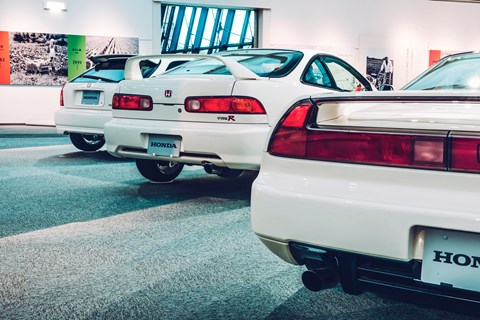
Light, high-revving, fine-handling Type R bloodline is, when you see it like this (Civic, Integra and NSX),one of considerable pedigree.
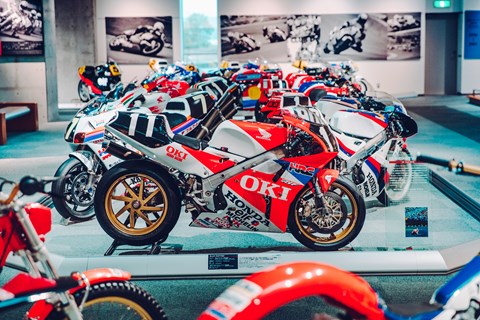
To beat them Honda had to join them in Grand Prix motorcycle racing, admitting defeat with its valiant NR four-stroke project before running a series of phenomenally successful two-strokes through the ’80s and ’90s. But the company’s first love will always be the four-stroke, preferably in a V4 format. ’91 RVF750 was a force to be reckoned with in endurance racing.
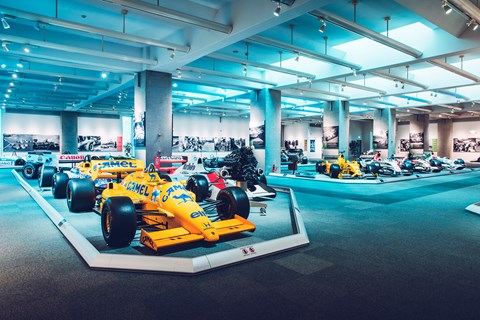
Highs and lows: nearest plinth is a place of success, with Williams, Lotus and McLaren F1 cars powered by turbo Honda V6s. Far plinth less so, though the 2006 RA106, engineered by the first works Honda F1 team since the late ’60s, won a race – Jenson Button’s first GP win.

Fastback S600 shows European influences, even if its powertrain was pure Honda. Soichiro had to go to the Japanese government for permission to paint his cars red – the colour had been reserved for emergency vehicles.
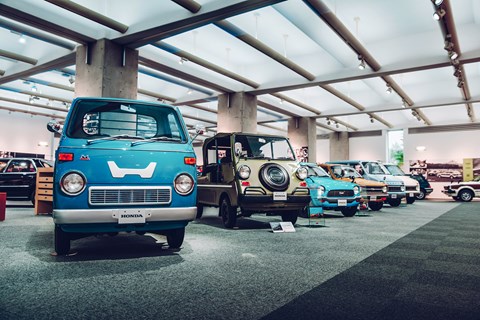
The funky face of utility – super-cool TN360 pick-up a successor to the T360, Honda’s first mass-produced four-wheeler.

So diminutive it makes a Super Cub moped look big, the S500 was Honda’s first passenger car. Chain final drive betrays its creator’s two-wheeled origins, as does the car’s screaming 531cc double overhead camshaft four that revs to 9500rpm…
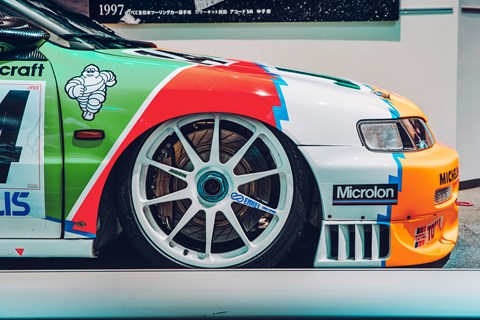
It’s an Accord but only just – 1996 SiR racer is loosely based on Europe’s fifth-gen Accord and won the ’96 All Japan Touring Car Championship. Driver sits on the floor with brake lines for company, while the wing mirror’s all about low-drag aero.
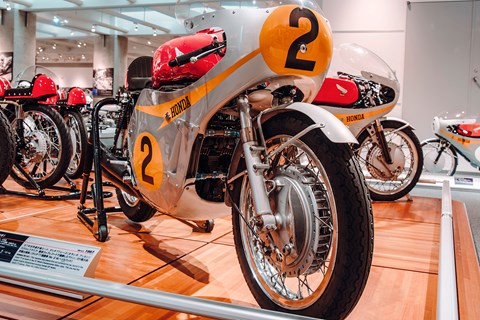
The first motorcycle to bear the Honda name was built in 1947; a tiny 0.5bhp two-stroke. Twenty years later Mike Hailwood’s 500cc RC181 was a match for anything the more storied European marques could create; 85bhp at 12,000rpm and complete reliability.
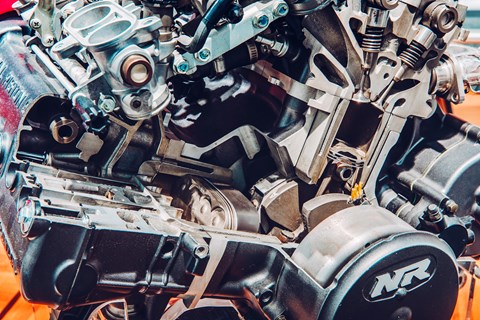
The NR750 superbike’s fiendishly complex ‘oval’-pistoned V4 was a love letter to the performance four-stroke. The pistons, shaped like a running track, run on pairs of con-rods and squeeze chambers fed by eight valves each. The production 750 developed a healthy 130bhp but the NR race engine managed the same from just 500cc.

First-generation Insight (green, far left) beat the Toyota Prius to market in the US but its compact size and teardrop shape made it a niche two-seater where the Prius had the second row of seats. The Toyota went on to become one of the world’s best-selling cars… Boxy City was early to the trend for taller kei cars, for more space on a given footprint.

Great days… Think Honda in F1 and you think not of their current hybrid woes but of this, the mighty twin-turbo V6 developed initially for Lotus (this is an ’87 RA166-E, rated at 935bhp) and then adopted by McLaren in the all but unbeatable MP4/4 (15 wins from 16 races).

GT2-spec NSX lacked grunt compared to Porsche and Corvette rivals at Le Mans in ’95, but the same poor weather that helped the McLaren F1 to overall victory saw the NSX win its class
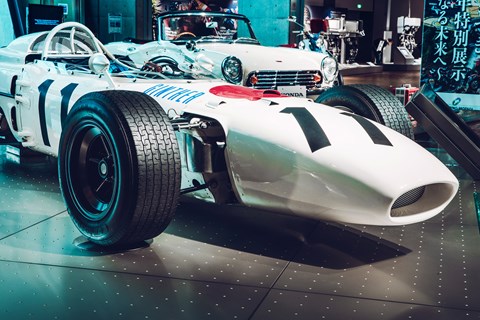
The first Honda F1 car to win a Grand Prix, the delicate RA272 weighed just 498kg and ran a 1495cc V12 with diddy 58mm cylinder bores… It won the last F1 race run under the 1500cc regulations against a field overwhelmingly V8-powered. Painfully skinny anti-roll bars look fit for a Caterham
**Honda: The future – CEO Takahiro Hachigo on what’s next

‘We will launch the Urban EV [city sister car of the Sports EV, right] in Europe in 2019. We are going to create a dedicated EV platform and the Urban EV will use this. With the Sports EV Concept we try to maximise the joy of driving. We don’t have plans to make the Sports EV yet – it depends on feedback from Europe and Japan.’
‘We will position these EVs as iconic cars for the Honda brand because they present our intention to accelerate electrification. The Urban EV will be your close friend as a city commuter. It will be connected, with artificial intelligence, and it will be fun to drive. This model will change the image of Honda. We will also launch a commercial vehicle based on the Urban EV platform.’
‘We see ourselves as the world’s number one mobility company, selling products to 28 million customers per year.’
‘Globally speaking, two-thirds of all four-wheeled Honda vehicles will be electrified by 2030. For Europe we have a different milestone: 2025. As far as hybrids are concerned, Honda has already sold two million units worldwide. Therefore the next European models focused on electrification are further hybrid models and plug-in hybrid models – these will accelerate the electrification of our vehicles in Europe. Then we will focus on genuine EVs.
‘I believe we are ahead of our competitors in terms of control technology for EV powertrains and batteries and motors, so we can leverage that technological know-how to lead.’
‘We believe that the fuel cell is the ultimate zero-emission vehicle technology, because a fuel cell vehicle produces power within the car and can be used in the same manner as a conventional petrol car. Cost and infrastructure are the big challenges, but we are not the only one in control of everything around these areas, so we will continue to run parallel EV and fuel cell zero-emission programmes. To mitigate costs we have already formed a fuel cell joint venture with GM, and to have better infrastructure in Europe we are exploring possibilities around collaborations with counterparts and governments.’
‘We must conduct further studies before we can decide whether the S2000 should be reinvented or not. I hear many voices expressing an interest, and Honda’s engineers are always quick to respond to requests for sporty cars, but the sales people must be enthusiastic.’
‘It is unfortunate that we had to part ways with McLaren before fulfilling our ambitions [in F1], however this is the best course of action for each other’s future.’
Check out our Honda reviews